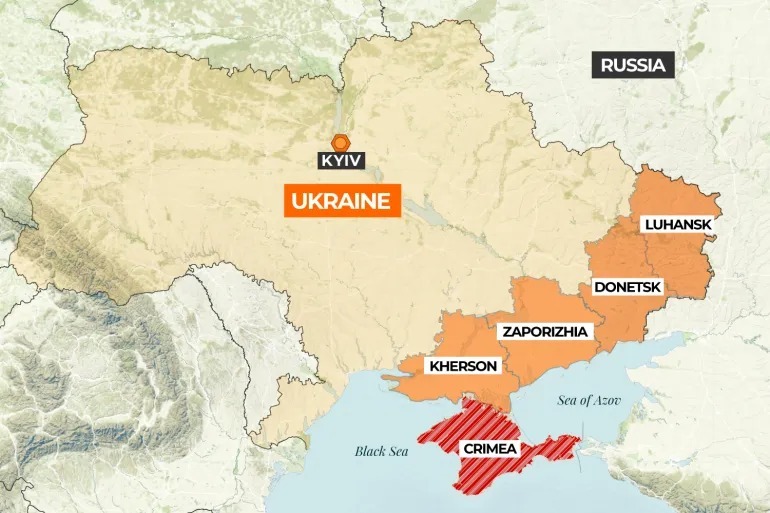28 Peace Point Plan – Russian Acceptance or Conceding to Russia
Understand the 28-Point Peace Plan drafted by the US and Russia to end the Russia-Ukraine war. Learn about the roots of the conflict, global geopolitical shifts, India’s strategic stance, key provisions of the plan, and its prospects for a ceasefire.
28 Point Peace Plan
The US President has recently unveiled the 28-Point Peace Plan to stop the Russia-Ukraine war.
What are the major provisions of this plan?
- Ukraine’s Limited Sovereignty: While the plan confirms that the sovereignty of Ukraine will be respected by all parties, with regions like Crimea, Luhansk and Donetsk being ceded to the Russians, considering their current occupation.
- Non-Expansion of NATO: One of the major bones of contention between Russia and Ukraine has been Russia’s reluctance to the eastward expansion of NATO. This expansion has continued even after the disintegration of the Soviet Union. The NATO will also not station any kind of troops in Ukraine.
-
-
- The amendment in the Ukrainian Constitution will facilitate this as it will not be part of the NATO, along with a similar kind of statute in the NATO.
-
- Security Guarantee for Ukraine: The proposal to bring Ukraine into the NATO was primarily based on the pivot of a security guarantee that was fading since the disintegration of the Soviet Union, something that was missed during the Budapest Memorandum (1994). Considering that Ukraine won’t be part of this collective defence group, the proposal seeks a reliable security guarantee, with Russia complying with the rules of non-aggression against Ukraine and other parts of Europe.
- Inclusion of Russia in G-7: While Russia was suspended from the G-7 (earlier G-8), due to its invasion of the Crimean peninsula, which led to a huge rift between the US and Russia, it will be brought back inside. President Trump mainly proposes this attempt to avoid the Russia-China nexus that is expanding its bloc in the world order.
- Russian Integration into Global Geoeconomic Order: The plan also brings the aspect of the Russian economy back into the global fold, as it has been marred with a wide range of sanctions due to its expansionist policies in the case of Georgia and Ukraine.
- Reconstruction of the Ukrainian Infrastructure: The peace plan comes with an overhaul idea for rebuilding the Ukrainian infrastructure, through financing arrangements around the Ukrainian Development Fund, Russian frozen assets, a special financing package by the World Bank (Marshall Plan 2.0, as claimed by many experts), and 100 billion USD support from the European Union.
- Establishment of the Humanitarian Committee: Such a body will ensure the return of all detainees during the war, including prisoners of war and the exchange of dead bodies, along with family reunifications and measures to alleviate their sufferings.
- Formation of the Peace Council: To ensure legal enforcement of the peace plan, a Peace Council will be formed, headed by the President Trump. This will reinforce sanctions in the case of violations of the plan.

Why are the clauses concerning?
- Conceding to Russian Demands: The peace plan, through its wide range of provisions, is a clear indicator that it is accepting all demands of Russia, in the form of occupation over the territories, non-expansion of NATO, etc., thus addressing all concerns of Russia.
- West Succumbing to Russian Gas Diplomacy: While efforts have been made during the War to impose not just sanctions but also to curb the procurement of Russian gas (like stopping Nord Stream 2 Pipeline), the Russian economy proved to be robust as it understands the demand of the Europe (Falin doctrine), along with providing crude oil at a discounted price to countries like India. With Russia’s integration into global geoeconomics, it has proved to the Western hemisphere that Russia has stood the test of time.
- US Trying to be Representative of Ukraine: The peace proposal is mainly hatched by the Americans and Russians, with the US trying to be representative of Ukraine, which is a signal that the plan has the element of illegitimacy, as it does not have the voice of Ukraine.
- Concession to Ukrainians on the Grounds of Infrastructure Development: With Ukraine losing a significant chunk of its land due to Russian aggression, along with significant concessions awarded to Russia and limited availability of Ukrainian military, it proves that the all Ukraine has received financial support for infrastructure development only.
- Question on Ukrainian Democracy: A crucial provision of the peace plan includes that the Ukraine has to ensure the conduct of elections within 100 days since it was not held during the war, thus questioning the very idea of electoral integrity that has been missing in Ukraine. However, the plan didn’t show the similar magnitude of courage when it comes to Russia.
- Expanded American Interest: Through this peace plan, the USA is eyeing the multifaceted hidden interests it entails. Firstly, ensuring the extraction of rare earth metals from the Arctic region. Secondly, exploration of minerals, natural gas, etc., in a joint collaboration with Ukraine.
The plan may take time to get any form of acceptance, considering that Ukraine won’t like to write its own death letter despite facing such aggressions, while Russian won’t like it on the grounds that Americans trying to consolidate their footprints in the Eastern Europe (Russian sphere of influence) and polar regions.
Subscribe to our Youtube Channel for more Valuable Content – TheStudyias
Download the App to Subscribe to our Courses – Thestudyias
The Source’s Authority and Ownership of the Article is Claimed By THE STUDY IAS BY MANIKANT SINGH


